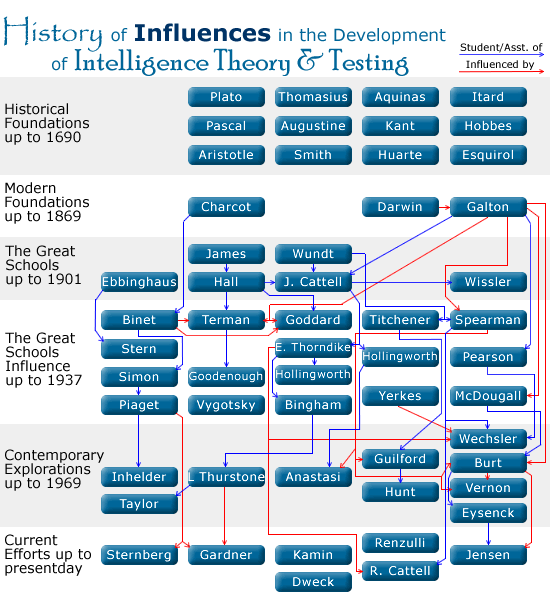A History in thought...
Leading figures and movements in the study of
intelligence.
Galton "the poor man's Darwin" (they were
cousins)
- 1869: Hereditary Genius: It's Laws
and Consequences
-
Coined term "eugenics" and phrase "nature
versus nurture"
Spearman: G-UNIT
- introduced the idea of a general
intelligence (g). This concept dominated intelligence studies up until
Jensen
Binet created the test. Stern
established the formula. And Terman labeled it.
- Binet devised the first intelligence (not IQ)
test to determine which students required extra help in school. He then
helped the French government produce a test for culling out those children
who would not benefit from further schooling.
Stern
- Formula for IQ: Mental Age/ Chronological Age
x 100 = IQ
- A Psychometric view of intelligence
maintains that standardized tests are the most accurate measure of
intelligence. How do you measure up?
- Binet did not agree with with the
premise of IQ.
During World War I, the United States Army
required all new draftees to take an IQ test. It was used to quickly
process the large number of incoming troops.
- This is the first instance of mass
compulsory testing.
1927: "Three generations of imbeciles are
enough."
- Supreme Court Justice Oliver Wendall Holmes
supported state sterilization of people whose IQ tests identified them as inferior
intellectual specimen.
Wechsler
1971: U.S. Supreme Court banned the use of IQ
tests in employment (with allowances for the occasional exception).
Flynn Effect
- 1984: James Flynn published.
- He gathered data from IQ tests in
twenty of the world's industrialized nations.
- He documented an increase of over three
points per decade. Flynn was the first person to use a
cross-generational approach for the interpretation of IQ.
- Unlikely that intelligence has
increased--more likely some "abstract problem-solving ability"
- "Small genetic differences get picked up
and magnified in the environment, resulting in dramatically enhanced skills"
- are we simply better test takers?
Gardner
- disassembled the monolithic g
by identifying seven types of human intelligence in his book, Frames
of Mind (1983).
Social Darwinism
- Some people are better than others due to innate (meaning
hereditary)
- Herrnstein and Murray published The Bell Curve
in 1984. Their study concluded that, among other things, the United
States should restructure itself as a custodial state.
- Of course, the book's most controversial
assertion was that African-Americans were intellectually inferior to their
Caucasian counterparts due to
innate hereditary differences.
from "Darwinistic Elitism is Idiotic" by. Al Siebert, PH.D

index
next page
This website was created
for H0NOR210: The Ideal, a course offered at Monmouth College during the fall
2005 semester.

